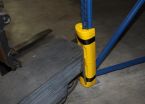Performance goals needed now for offshore wind turbine industry in US
2011-04-29
(Press-News.org) WASHINGTON — Structural Integrity of Offshore Wind Turbines: Oversight of Design, Fabrication, and Installation, a new report from the National Research Council's Transportation Research Board, examines standards and practices that could be used to design U.S. offshore wind installations.
In order to develop offshore wind energy in the United States, a clear set of requirements is needed, the report says. As the U.S. currently lacks standards, the committee that wrote the report recommends that the U.S. Department of the Interior's Bureau of Ocean Energy Management, Regulation, and Enforcement (BOEMRE) immediately establish performance goals for structural integrity that project developers must meet. Performance goals, rather than prescribed regulations, would encourage innovation in this nascent industry. The industry should then rely on a combination of international standards and guidelines developed by classification societies, as well as designs appropriate for U.S. waters and weather conditions, to develop projects that comply with the performance goals. The committee also suggests roles for third-party reviewers and identifies expertise required to advise BOEMRE on the suitability of industry proposals.
INFORMATION:
The study was sponsored by BOEMRE. The National Academy of Sciences, National Academy of Engineering, Institute of Medicine, and National Research Council make up the National Academies. They are private, nonprofit institutions that provide science, technology, and health policy advice under a congressional charter. The Research Council is the principal operating agency of the National Academy of Sciences and the National Academy of Engineering. For more information, visit http://national-academies.org.
Contacts:
Maureen O'Leary, Director of Public Information
Luwam Yeibio, Media Assistant
Office of News and Public Information
202-334-2138; e-mail news@nas.edu
END
ELSE PRESS RELEASES FROM THIS DATE:
2011-04-29
At the end of a long day on the job, the warehouse employee wants to deposit the last palettes quickly before heading home. With a little too much momentum he steers his forklift toward the shelf and collides with a shelf support. This is an every- day situation in large warehouses in which employees often have to maneuver goods through the narrow aisles, often under time pressure. Even harmless-seeming collisions are not really safe though, because over time they may in fact destabilize the shelf supports. In the worst case, the high-rack storage can come crashing down ...
2011-04-29
Researchers are reporting results from the first year of a two-year clinical trial that Avastin, a drug approved to treat some cancers and that is commonly used off-label to treat age-related macular degeneration (AMD), is as effective as the Food and Drug Administration-approved drug Lucentis for the treatment of AMD.
The report, from the Comparison of AMD Treatments Trials (CATT), was published online in the New England Journal of Medicine on Sunday, May 1, 2011. CATT is funded by the National Eye Institute (NEI), a part of the National Institutes of Health.
"Over ...
2011-04-29
Only when you are standing beside a wind turbine can you appreciate the immense size of the wind turbine and its rotor blades. The largest wind turbines operating in the world today have rotor blades over 60 meters long – roughly equivalent to three truck-and-trailer units end-to-end. Within the next ten years, manufacturers of high-output wind turbines for offshore wind farms plan to produce blades up to 90 meters long. The prototypes of these new blades have to be tested and certified before they can go into production, and that requires equally as large testing facilities.
The ...
2011-04-29
A year after the BP explosion and oil spill, those trying to find someone to blame are misguided, says psychological scientist E. Scott Geller, Alumni Distinguished professor at Virginia Tech, and author of a new paper published in Current Directions in Psychological Science, a journal of the Association for Psychological Science. Geller has spent much of his 42-year career developing interventions to keep people safe, particularly helping companies develop a culture that promotes occupational safety.
There's almost never one person to blame for an injury; instead, companies ...
2011-04-29
Nanoparticles will soon be used as tiny shuttles to deliver genes to cells and drugs to tumors in a more targeted way than was possible in the past.
But as the scientists prepare to use the nanoparticles in medicine, concerns have arisen about their potential toxicity.
Studies of both the applications of nanoparticles and their toxicity rely on the ability of scientists to quantify the interaction between the nanoparticles and cells, particularly the uptake (ingestion) of nanoparticles by cells.
In the standard laboratory tests of the biological activity of nanoparticles, ...
2011-04-29
The fishing industry usually discards fish livers, but a team of researchers from the University of Almeria (Spain) has confirmed that they are a good source of polyunsaturated fatty acids, which are beneficial to health. Anchovies are one of the fish whose livers contain the highest levels of these substances.
Fish livers have hardly been used to date, with exceptions such as cod livers, which are used to produce the well-known medicinal oil. In general, fishermen tend to throw fish entrails away into the sea, and if they make it to processing plants they are one of ...
2011-04-29
Dr. Michael Collins, Naval Research Laboratory scientist and bird watcher, has published an article titled "Putative audio recordings of the Ivory-billed Woodpecker (Campephilus principalis)" which appears in the March issue of the Journal of the Acoustical Society of America. The audio recordings were captured in two videos of birds with characteristics consistent with the Ivory-billed Woodpecker. This footage was obtained near the Pearl River in Louisiana, where there is a history of unconfirmed reports of this species. During five years of fieldwork, Collins had ten ...
2011-04-29
One of the most critical tasks that a dividing cell must accomplish is the successful delivery of a complete set of genetic information to each new daughter cell. Now, a study published by Cell Press in the April 29th issue of the journal Cell, provides fascinating new insight into the complex of proteins that orchestrates the proper segregation of human chromosomes during cell division.
During the process of mitosis, DNA and its associated packing proteins are arranged into structures called chromosomes that are duplicated and then segregated. Duplicated chromosomes ...
2011-04-29
It's common knowledge that the perfect is the enemy of the good, but in the nanoscale world, perfection can act as the enemy of the best.
In the workaday world, engineers and scientists go to great lengths to make the devices we use as perfect as possible. When we flip on a light switch or turn the key on the car, we expect the lights to come on and the engine to start every time, with only rare exceptions. They have done so by using a top-down design process combined with the application of large amounts of energy to increase reliability by suppressing natural variability.
However, ...
2011-04-29
The 25-story construction crane used since 1995 to investigate such things as how Pacific Northwest forests absorb carbon dioxide, obtain sufficient water and resist attacks by pests and diseases is being pruned back to just the tower.
The Wind River Canopy Crane, located in a 500-year-old forest near Stevenson in southwest Washington, has been operated cooperatively by the University of Washington, the Forest Service's Pacific Northwest Research Station and the Gifford Pinchot National Forest. The partners say the jib – the arm of the crane – is being removed because ...
LAST 30 PRESS RELEASES:
[Press-News.org] Performance goals needed now for offshore wind turbine industry in US






